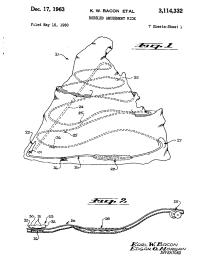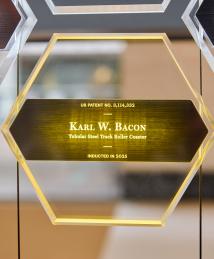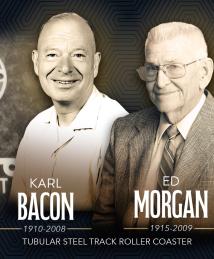Karl Bacon
Karl Bacon and Ed Morgan engineered the world’s first tubular steel track roller coaster. Matterhorn Bobsleds debuted in 1959 at Disneyland in Anaheim, California, and set the standard for roller coaster design technology.
Born in Oakland, Maine, in 1910, Bacon was a self-taught engineer with a naturally mathematical mind. While working as head of machine tool maintenance at Hendy Iron Works, a U.S. Navy contractor in Sunnyvale, California, that built torpedo launchers and marine steam engines, he met fellow National Inventors Hall of Fame® Inductee Ed Morgan in 1943.
In 1946, Bacon, Morgan and two of their Hendy colleagues, Bill Hardiman and Andy Anderson, co-founded a small machine shop called Arrow Development in Mountain View, California. In addition to making truck parts and tools, building vending machines and playground equipment, and performing machine work for HP Inc., they began building carousels and other rides for local amusement parks.
In 1953, National Inventors Hall of Fame Inductee Walt Disney hired Arrow Development to work with WED Enterprises, now Walt Disney Imagineering, to design and construct original rides for the Fantasyland area of Disneyland, which would open in 1955. These included the Mad Tea Party, Dumbo the Flying Elephant, Mr. Toad’s Wild Ride, Snow White’s Scary Adventures and Casey Jr. Circus Train. Following the success of these rides, Arrow was contracted to build several more, including Matterhorn Bobsleds – Disneyland’s first roller coaster.
While visiting the Swiss Alps, Disney had been inspired to create a ride that would simulate the excitement of racing down icy slopes in a bobsled. His team of Imagineers designed a 147-foot-high, 1/100 scale replica of the Matterhorn, a famous Swiss mountain, in steel and concrete. Arrow was tasked with designing two 80-foot-high steel roller coaster tracks that would intertwine through the artificial mountain.
Conventional angle iron tracks could not be bent into a small enough radius to fit within the space, so Bacon and Morgan developed a solution – tubular steel tracks. After first testing the tracks with nylon wheels, the inventors chose to use polyurethane wheels because they were quieter than steel and created less friction than rubber. To prevent the Matterhorn’s cars from derailing as the coaster navigated curves at high speeds, they designed the rails to surround the wheels, rather than having the wheels ride on top of the rails.
Bacon and Morgan also created a novel “booster” device to keep each car moving at the same pace. Monitored by control room workers, this device was composed of a rubber tire attached to a motor installed on the tracks. The tire would contact a plate on the bottom of each car, speeding it up or slowing it down as needed.
Matterhorn Bobsleds ignited a revival in the amusement park industry. In fact, as a Los Angeles Times article stated, "Virtually every roller coaster since Matterhorn can trace its lineage to Arrow's breakthrough innovation on the now-classic Disneyland ride." Bacon and Morgan’s tubular steel track design offered a smoother, quieter ride compared to wooden roller coasters and paved the way for ride designers to create spiral tracks, longer drops, loops and other features that would previously have been too dangerous or even impossible to create.
Arrow also built dark rides and in 1963, the company designed and built the world’s first modern log flume ride, El Aserradero (The Sawmill) for Six Flags Over Texas. Studying and applying the U.S. Navy’s research on hydrodynamics, Bacon optimized the ride’s water levels, slopes, artificial rapids and turns to ensure a constant water level and speed. Following El Aserradero, Arrow sold more than 50 flume rides to theme parks in the U.S. and Europe.
Bacon and Morgan sold their interests in Arrow in 1973, having made a lasting impact on the amusement park industry. They were awarded the 1998 International Association of Amusement Parks and Attractions Hall of Fame Award and Matterhorn Bobsled was recognized with the 2003 American Coaster Enthusiasts Coaster Landmark Award. They remained close friends for life, and when Bacon passed away in 2008, Morgan reflected on his co-inventor’s drive to innovate, stating, “The most important factor is that Karl was a genius.”


